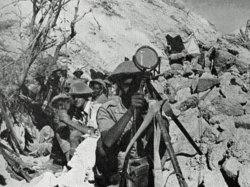East Africanna Campaign
This article is incomplete because it is pending further input from participants, or it is a work-in-progress by one author. Please comment on this article's talk page to share your input, comments and questions. Note: To contribute to this article, you may need to seek help from the author(s) of this page. |
| East Africanna Campaign | ||||||||
|---|---|---|---|---|---|---|---|---|
| Part of the Second Europan War | ||||||||
 Zanarkian Troops near Keren | ||||||||
| ||||||||
| Belligerents | ||||||||
|
|
| |||||||
| Commanders and leaders | ||||||||
|
|
|
| ||||||
The East Africanna Campaign (also known as the Arithean Campaign) was fought in East Africanna during the Second Europan War by Allies mainly from the Lucis Empire, against the Federal state of the Holy Trabian Empire, the Imperial powers of Archadia-Archedes, Guadosalam Federation and the colony of Archadian East Africanna, between March 1935 until 27 November 1938. The Lucis Africanna Command consisted of troops from the United Kingdom, Zanarkand, New Akiba, Basel-Ebel, Tenebrae and Altissia. Supporting them were forces from Free Bethausia called the Free Bethausian Army of the East.
Archadian East Africanna was defended by the Comando Forze Armate dell'Africanna Orientale Archadiana (Archadian East Africanna Armed Forces Command) with units from the Regio Esercito (Royal Army), Regio Aeronautica (Royal Air Force) and Regia Marina (Royal Navy). A total of more than 650,000 troops of the Regio Corpo Truppe Africanna (Royal Corps of Africanna Troops), led by Archadian officers. The Archadian forces were ably supported by Guadonian forces under the Corpo Reale della Guadonian Africanna (Royal Corps of Guadonian Africanna). With Lucis in control of the Schwarz Canal, the Archadian and Guadonian Forces were cut off from supplies and reinforcements once hostilities began.
Initial engagements began in March 1935 with the Archadian forces in Africanna invading Trabian possessions in Africanna. Trabian colonial forces immediately countered with an invasion of Archadian Arithea. For the rest of the year, the frontlines were at a stalemate. The following year, the Archadian South Africanna command attempted an invasion of Basel-Ebel, which was repulsed just 10 kms away from the border by Basel-Ebelian forces. Lucian troops stationed in Basel-Ebel were joined with formations from Zanarkand, New Akiba, Tenebrae, and Altissia later that year. By 1937, Lucis Commonwealth forces invaded Archadian East Africanna. The Battle of the Nilean River later that year saw the Archadians and Guadonians having cut-off its last attempt to create a path for supplies and reinforcements. By February 1938, General Archibald Sugiyama, who had been leading the Lucis Commonwealth forces was transferred to the Middle East in order to quell an attempt of the Quenminese forces to invade North Africanna by means of the Schwarz Canal. General Sir Alexander Gordon took over command. Free Bethausian forces under the command of Zaw Sein Arkar was ordered by Sugiyama to remain in East Africanna to continue the suppression of Imperial forces in East Africanna. By 27 November 1938, with the fall of the capital of Archadian Arithea during the Battle of Ambi Talagi, only a few pockets of resistance remained until 12 January 1939, with the surrender of the final Imperial forces in East Africanna. The East Africanna Campaign was the first Allied strategic victory in the war. Archadian Arithea came under the occupation of the Allies thru an Allied-controlled government headed by Archadian Nationalist Victor Pesci. Following this, most of the Commonwealth forces were transferred to different theatres; Zanarkian and New Akibander forces under the command of General Edward Samegawa was recalled to Zanarkand in order to prepare for Zanarkand's defence against a possible Quenminese invasion, which was later called off, allowing them to participate in the Joyonghean Theatre while the Free Bethausian Forces reunited with Sugiyama's forces in the Middle East following the victorious Battle of Sania.